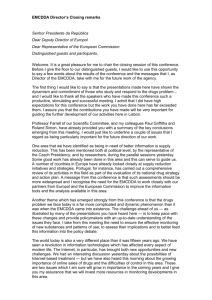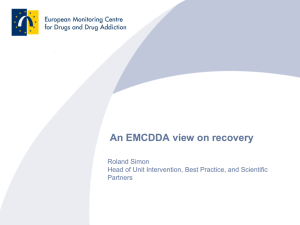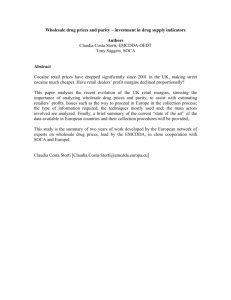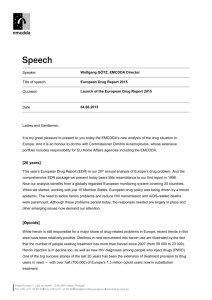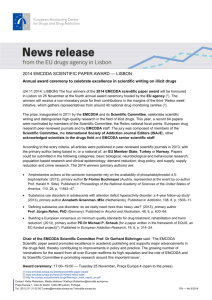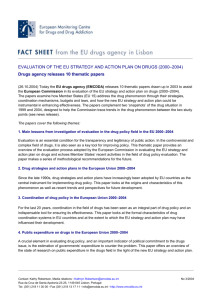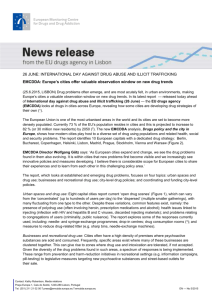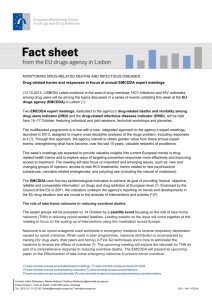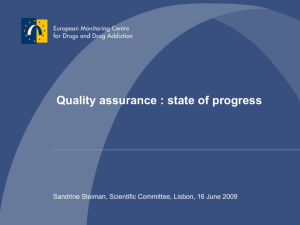DOC - Europa
advertisement
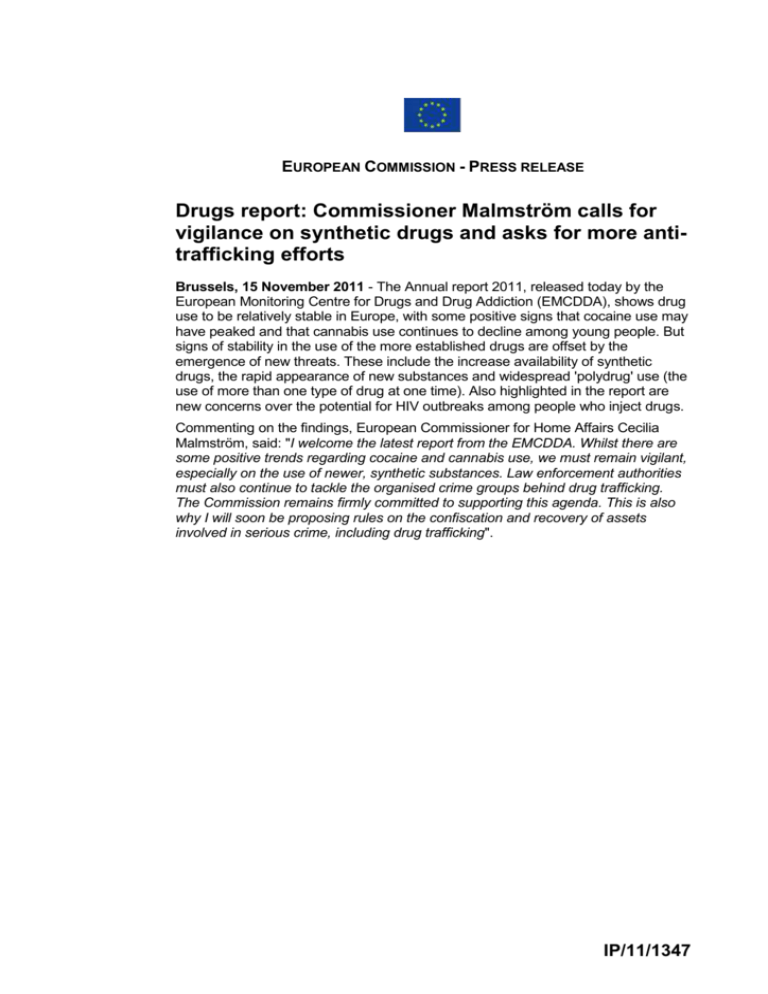
EUROPEAN COMMISSION - PRESS RELEASE Drugs report: Commissioner Malmström calls for vigilance on synthetic drugs and asks for more antitrafficking efforts Brussels, 15 November 2011 - The Annual report 2011, released today by the European Monitoring Centre for Drugs and Drug Addiction (EMCDDA), shows drug use to be relatively stable in Europe, with some positive signs that cocaine use may have peaked and that cannabis use continues to decline among young people. But signs of stability in the use of the more established drugs are offset by the emergence of new threats. These include the increase availability of synthetic drugs, the rapid appearance of new substances and widespread 'polydrug' use (the use of more than one type of drug at one time). Also highlighted in the report are new concerns over the potential for HIV outbreaks among people who inject drugs. Commenting on the findings, European Commissioner for Home Affairs Cecilia Malmström, said: "I welcome the latest report from the EMCDDA. Whilst there are some positive trends regarding cocaine and cannabis use, we must remain vigilant, especially on the use of newer, synthetic substances. Law enforcement authorities must also continue to tackle the organised crime groups behind drug trafficking. The Commission remains firmly committed to supporting this agenda. This is also why I will soon be proposing rules on the confiscation and recovery of assets involved in serious crime, including drug trafficking". IP/11/1347 Background Around 14.5 million Europeans (15–64 years) have tried cocaine in their lifetime, some 4 million having used it in the last year. Recent surveys of cocaine use reveal some positive signs in the most affected countries. Denmark, Spain, Italy and the UK, for example, (four of the five countries with highest levels of use) report some decline in last-year's cocaine use among young adults (15–34 years). Around 78 million Europeans — one in five adults aged 15–64 years — have tried cannabis in their lifetime, with around 22.5 million of them having used it in the last year. This means that cannabis is still Europe’s most commonly consumed illicit drug. However, the latest European data confirms a general stabilising or downward trend in cannabis use among young adults. The report reveals a cat-and-mouse game in the area of precursors, the chemicals used to manufacture illicit drugs. It shows how producers of synthetic drugs are using sophisticated techniques to bypass regulations intended to prevent the diversion of these precursors. These include: synthesising precursors from ‘preprecursors’ or masking them as non-controlled chemicals, to be reconverted after importation. Recent fluctuations in the ecstasy market illustrate this phenomenon. The rapid emergence of new non-controlled psychoactive substances (often sold as ‘legal highs’) represents a growing challenge. Following the record 41 new drugs notified to the EMCDDA and Europol in 2010 (compared to 24 in 2009), preliminary data for 2011 presented today shows that there are no signs of decline. So far in 2011, 39 substances have been reported via the European early warning system (EWS). The most recent EMCDDA snapshot of online retailers of legal highs (July 2011) identified a record 600 online shops purportedly selling psychoactive products and revealed a wide variety of new products on offer. Finally, heroin use still accounts for the largest share of drug-related diseases and deaths in the EU. The EMCDDA estimates that there are over 1.3 million regular opioid users in the EU and Norway. Around half of the drug users entering specialised treatment in Europe report opioids as their main problem drug. Today's report highlights new concerns over the use of opioids other than heroin and the potential for HIV outbreaks among people who inject drugs. In order to tackle the traffic of drugs more effectively, the Commission also intends to propose new rules on the confiscation and recovery of assets. The distribution chains behind drug trafficking are often organised criminals. They operate for profit and it follows that we must not punish criminals with jail time, but also deprive them of financial gains, cars and property to make organised crime less profitable in the long run. For more information The report and full EMCDDA press pack in 22 languages: www.emcdda.europa.eu/events/2011/annual-report Homepage of Cecilia Malmström, Commissioner for Home Affairs http://ec.europa.eu/commission_2010-2014/malmstrom/welcome/default_en.htm Homepage DG Home Affairs: http://ec.europa.eu/dgs/home-affairs/index_en.htm 2 Contacts : Michele Cercone (+32 2 298 09 63) Tove Ernst (+32 2 298 67 64) 3
